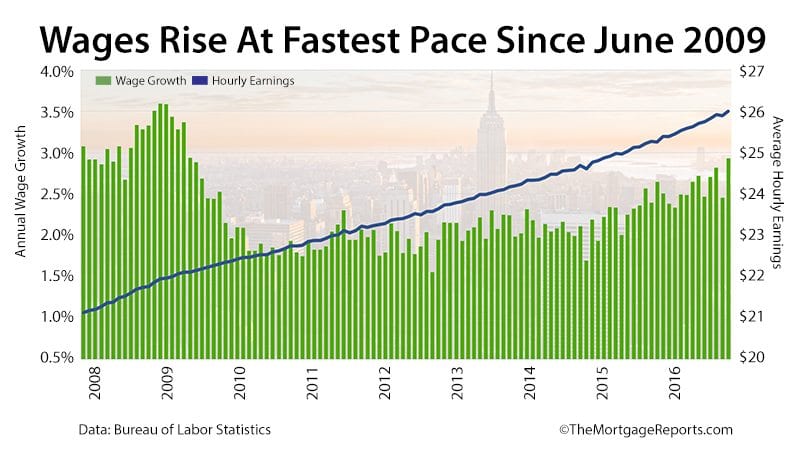
More Jobs Added To The Economy; Workers Getting Paid More
Mortgage rates are rising after release of the December Non-Farm Payrolls report.
Job growth came in below expectations, but that was offset by upward revisions for November.
The job market is strong, adding more than 2 million jobs to the economy in 2016 alone.
Generally, mortgage rates move higher in an improving economy.
Somewhat worrisome for mortgage rates shoppers are rising worker wages. Employees are making nearly three percent more than they were one year ago.
That’s the highest year-over-year gain since June 2009.
Rising wages cause inflation, and inflation is bad for mortgage rates.
Still, December’s data is having a limited effect on mortgage rates — at the moment — and rate shoppers can benefit by capitalizing on today’s still-low rate levels.
Click to see today’s rates (Jan 12th, 2017)
The Effect Of The Jobs Report
On the first Friday of each month, the Bureau of Labor Statistics releases its Non-Farm Payrolls report.
More commonly known as “the jobs report”, Non-Farm Payrolls gives a detailed look at the nation’s workforce. The report includes jobs by sector, average earnings, and the national unemployment rate.
The Non-Farm Payrolls report is among each month’s most closely-watched economic releases because so much of the U.S. economy is tied to jobs.
When the labor force is expanding and average wage earnings increase, the economy tends to expand.
As more income is earned by U.S. households, more taxes are paid to federal, state, and local governments. This leads to the purchase of more goods and services by both consumers and governments, which keeps the cycle going.
A strengthening jobs economy also increases the disposable income available in the typical U.S. household, which can boost consumer confidence and personal consumption. This, too, promotes a cycle of strong growth.
Growth begets growth.
Conversely, when job growth is low and confidence is down, consumption tends to drop. In markets like this, less income is earned, fewer taxes are paid, and demand for goods and services falls.
In down markets, businesses have fewer reasons to hire new workers, and they often reduce the size of their existing workforce to something smaller.
This cycle, too, feeds on itself.
Because of the importance of jobs to the broader U.S. economy, economists watch the Non-Farm Payrolls report closely.
Wall Street watches it, too, which is why “jobs” affect your mortgage rate.
Click to see today’s rates (Jan 12th, 2017)
December Non-Farm Payrolls Report: Wages Up 2.9% Year-Over-Year
The December Non-Farm Payrolls report showed 156,000 net new jobs created last month — lower than the consensus estimate of one hundred seventy five thousand jobs.
October and November Non-Farm Payrolls data was revised higher by a total of nineteen thousand jobs.
Average hourly wages were up in December, raising the annual increase in wages to 2.9%. This marks the highest reading of 2016, and also the highest in nearly seven years.
The data puts Wall Street on notice, and the Federal Reserve is no doubt at attention, too.
Remember that the job of the Federal Reserve is to maximize the U.S. labor market while maintaining stable prices throughout the economy. Since the start of the decade, more than 15 million jobs have been created and now wage growth is returning.
The Fed will consider the steady climb in worker wages during its first meeting of 2017, commencing on January 31.
Click to see today’s rates (Jan 12th, 2017)
Rising Wages Influence Fed Rate Hike Decision
Between December 2008 and December 2015, the Federal Reserve held the Fed Funds Rate in a target range near zero percent as a way to catalyze the U.S. economy.
Then, at the end of 2015, the group voted to raise the Fed Funds Rate to a target range between 0.25 and 0.50 percent, noting that future rate hikes were likely so long as economic conditions warranted them.
The Fed raised rates again at its December 2016 meeting. The Federal Funds Rate now stands between 0.50% and 0.75%.
The December 2016 Non-Farm Payrolls report, while not especially strong, does signal that the Fed was justified in raising its benchmark rate, and that more hikes could be coming.
Wages grew at the fastest pace since 2009. Mortgage rates rise during periods of heightened wage growth.
It’s all about inflation.
When wages rise, companies pass those costs to consumers by upping prices on goods and services. Consumers must pay more for the same things — the very definition of inflation.
As consumer expenses rise, companies and government agencies often increase wages again, and the cycle continues.
So, why is that bad for mortgage rates?
Simply put, investors shy away from investments whose value drops over time. They would rather acquire assets that increase in worth.
Mortgage-backed securities — the assets upon which mortgage rates are “made” — drop in value as inflation creeps up. For instance, an asset worth $100 today could be worth ninety-five inflation-adjusted dollars next year.
To make up for that loss, investors require higher interest rates to compensate for inflation, and then some.
Ideally — to an investor anyway — the rate of return always outstrips inflation. As inflation rises, so does the interest rate on any asset they agree to buy.
Hence, increasing inflation means higher mortgage rates for you.
The best course of action, then, is to lock in a mortgage rate while inflation concerns are still relatively low. As the economy heats up in 2017, unemployment could fall, wages could rise, and inflation could become a real factor within the economy.
The best mortgage rates may be the ones you find right now.
What Are Today’s Mortgage Rates?
The Non-Farm Payrolls report shows steady economic growth and a solid jobs economy. Eventually, this will affect mortgage rates negatively. For now, rate increases remain subdued.
Take a look at today’s real mortgage rates now. Your social security number is not required to get started, and all quotes come with instant access to your live credit scores.
Click to see today’s rates (Jan 12th, 2017)
The information contained on The Mortgage Reports website is for informational purposes only and is not an advertisement for products offered by Full Beaker. The views and opinions expressed herein are those of the author and do not reflect the policy or position of Full Beaker, its officers, parent, or affiliates.
mortgage-rates-rise-on-reignited-inflation-concerns

No comments:
Post a Comment